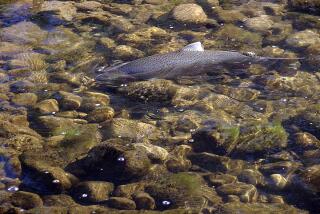Great white shark population is healthy and growing, new census shows
A new census study shows there are more than 2,400 white sharks off California and suggests that existing protective measures should be maintained because they are increasing the size and health of the population.
The study by a 10-member team led by George H. Burgess, director of the Florida Program for Shark Research, bolsters a recent National Oceanic and Atmospheric Administration determination that the eastern Pacific Ocean population of great white sharks does not warrant listing under the Endangered Species Act.
“That we found these sharks are doing OK, better than OK, is a real positive in light of the fact that other shark populations are not necessarily doing as well,” Burgess said. “We hope others can take our results and use them as a positive starting point for additional investigation.”
The team, like NOAA, began researching the status of the great white shark population in 2013, after the environmental groups Oceana, Shark Stewards and the Center for Biological Diversity filed a petition calling for endangered species protection.
The environmental groups were reacting to the first census of great whites ever attempted. Conducted by UC Davis and Stanford University researchers, and published in the journal Biology Letters in 2011, the census estimated that only 219 adult and sub-adult great whites lived off the Central California coast, and perhaps double that many were in the entire northeastern Pacific Ocean, including Southern California.
The great white shark, which can reach 21 feet, weigh 3 1/2 tons and hunts waters shared by surfers, scuba divers and swimmers, feeds at the top of the food chain and the status of their population can have cascading effects on species from sea lions to anchovies.
The surprisingly low estimate prompted environmentalists to launch fundraising campaigns to “save the great white shark from extinction,” and file the petitions that made Carcharodon carcharias the first candidate for listing as an endangered species in California ocean waters.
The UC Davis/Stanford University census also drew sneers from shark experts who claimed it was based on faulty assumptions. The actual white shark population, critics said, was likely 10 times larger -- a result of state and federal laws curbing pollution, banning near-shore gill netting, protecting sharks and halting the slaughter of marine mammals they prey on.
Caught in the middle were state and federal wildlife authorities who accepted the petitions for consideration because the census study was, at the time, the only available science on the subject that had been published in an internationally recognized scientific journal.
Earlier this year, the National Marine Fisheries Service and the California Department of Fish and Wildlife both determined that listing was not warranted.
“In this case, the environmental groups were too quick on the draw,” Burgess said in an interview. “Their hearts were in the right place, but their petitions cost taxpayers a heck of a lot of money and diverted resources away from species genuinely at risk.”
Follow me at @LouisSahagun for more fascinating stories







